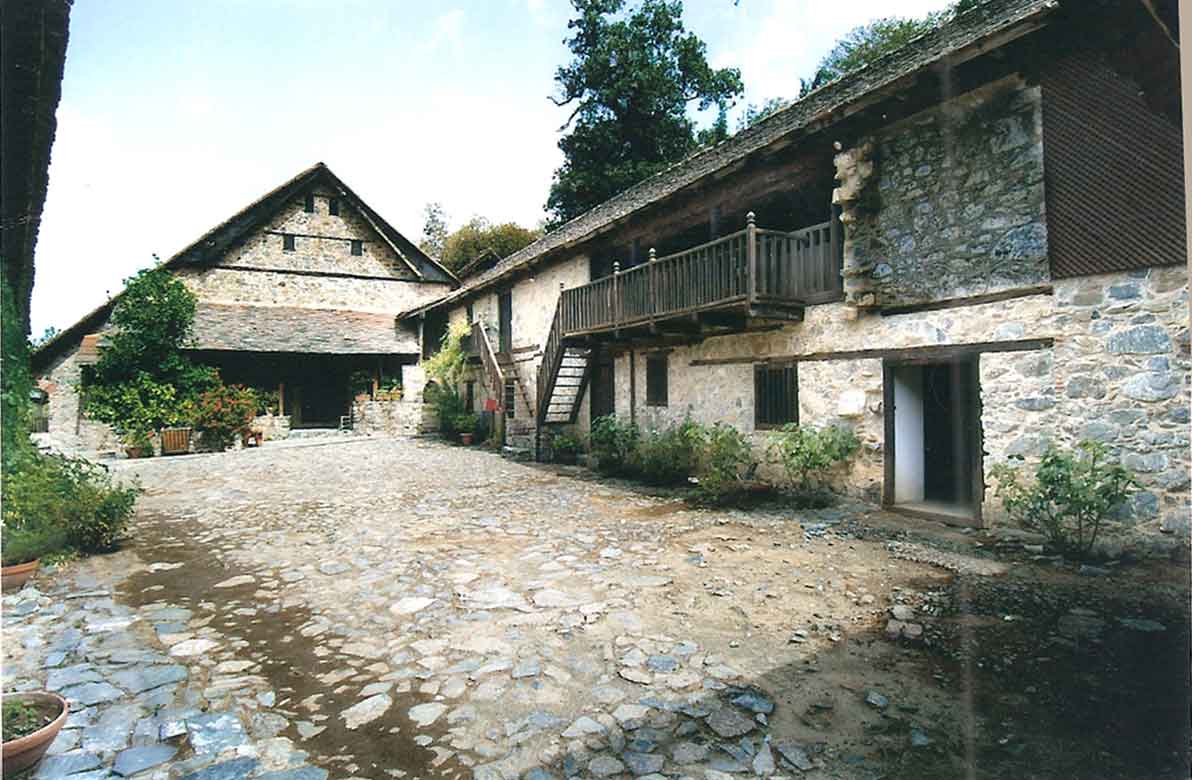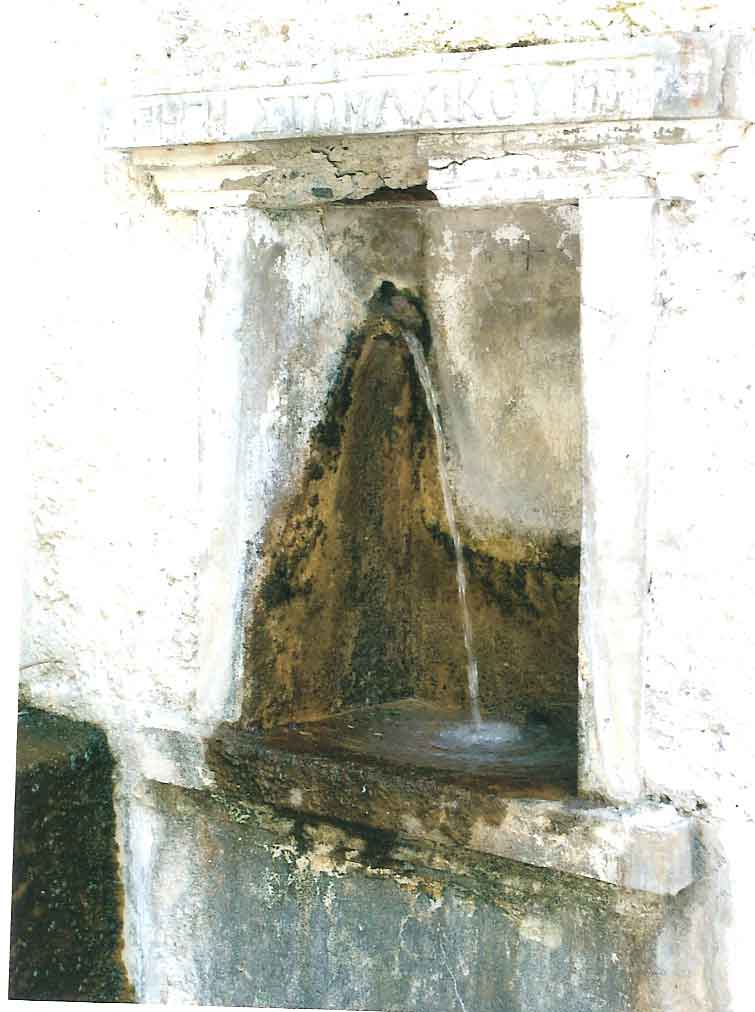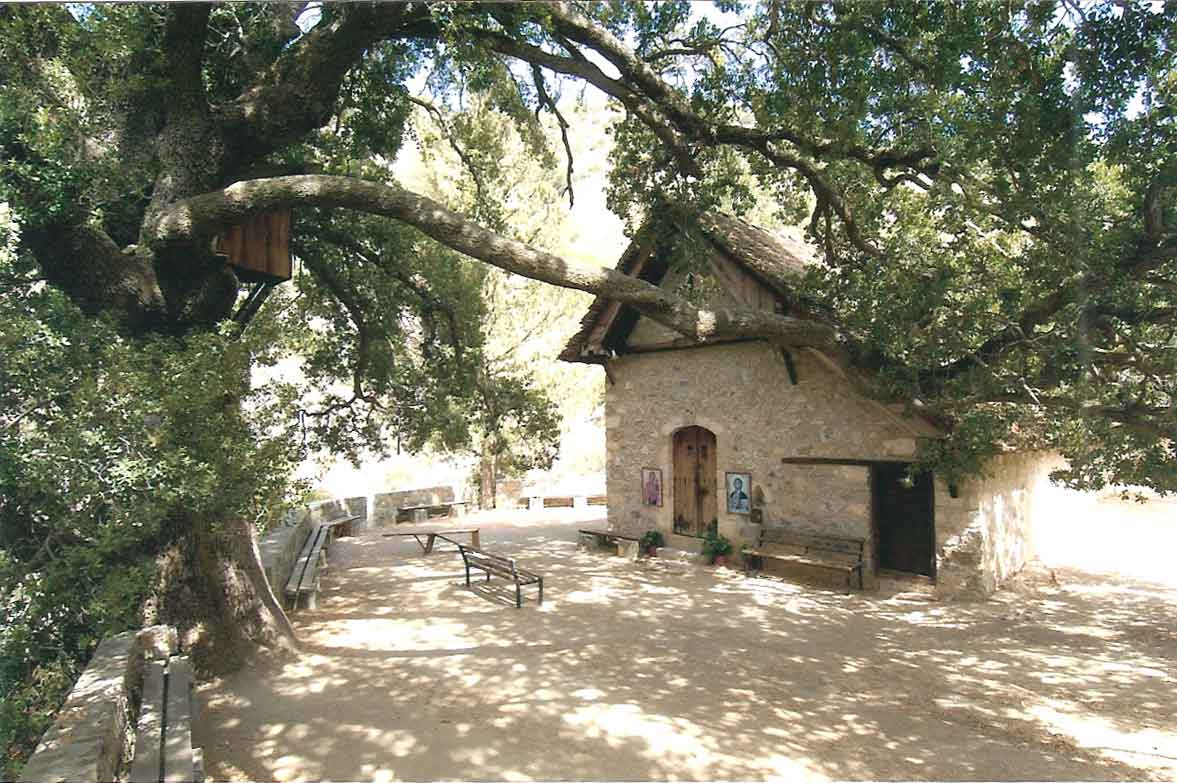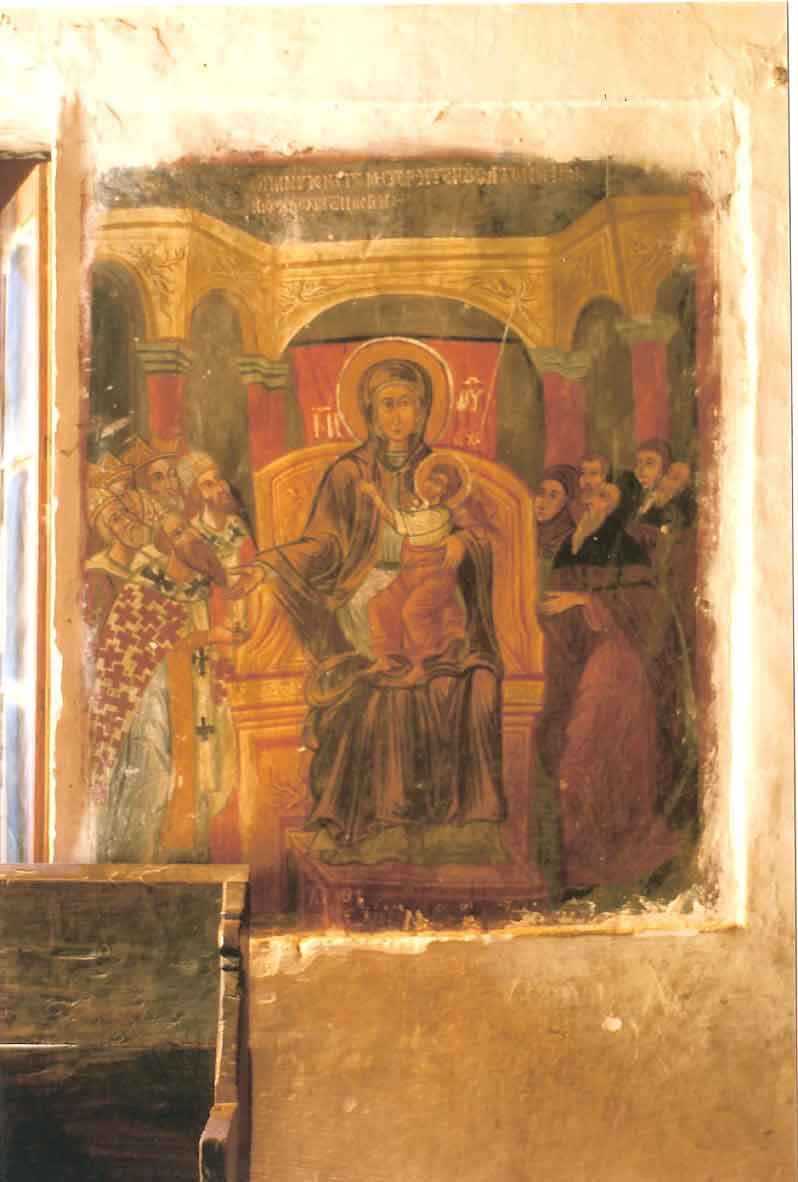things to do
 |
Ιερά Μονή Αγίου Ιωάννη του ΛαµπαδιστήΗ Μονή του Αγίου Ιωάννη του Λαµπαδιστή είναι βυζαντινού ρυθµού και αποτελείται |
Το Παρεκκλήσι της Παναγίας της Θεοσκέπαστης
Το παρεκκλήσι ή το ναίδριο της Παναγίας της Θεοσκέπαστης βρίσκεται ανατολικά της Μονής του Αγίου Ιωάννη του Λαµπαδιστή και πολύ κοντά σ’ αυτή. Προτού επισκευαστεί στις αρχές του αιώνα µας, το παρεκκλήσι ήταν διαιρεµένο σε δύο µέρη, τον «Ναό» και το «Νάρθηκα» στα δυτικά του. Στα δυτικά του παρεκκλησιού βρίσκονταν ερείπια κελιών και συµπεραίνεται ότι ήταν Σκήτη ή Ασκητήριο µοναχών, παράρτηµα της Μονής του Λαµπαδιστή. Το παρεκκλήσι σκεπάζεται από πανύψηλη και πυκνόφυλλη περνιά, που συνήθως είναι θάµνος. Δίπλα από την περνιά υψώνεται δρυς. Τα αιωνόβια αυτά δένδρα σώθηκαν γιατί, κατά την παράδοση, όσοι αποτόλµησαν να αποκόψουν κλαδιά από αυτά τιµωρήθηκαν άµεσα και αυστηρά από αόρατη θεία δύναµη. Επίσης η παράδοση λέγει ότι αυτά τα δένδρα προστάτευαν το παρεκκλήσι σκεπάζοντας το και κρύβοντας το από τους Τούρκους που τότε έκαιγαν και κατέστρεφαν τους χριστιανικούς ναούς.
Το Παρεκκλήσι του Αγίου Ανδρόνικου |
Το Παρεκκλήσι του Αγίου Κυριάκου
Το παρεκκλήσι αυτό κτίστηκε το 1722 και παλαιότερα είχε αποµεινάρια τοιχογραφιών.
Το Παρεκκλήσι του Αγίου Γεωργίου
Το παρεκκλήσι του Αγίου Γεωργίου έχει µία εικόνα του Παντοκράτορα του 15ου αιώνα και µία της Παναγίας του 1671.
Το Παρεκκλήσι της Παναγίας της Μολυβοσκέπαστης
Περίπου 3 µίλια από τον Καλοπαναγιώτη υπάρχουν τα ερείπια της Παναγίας της Μολυβοσκέπαστης ή «καλυµµένη µε µολύβι», που φαίνεται αρχικά να ήταν λατινική εκκλησία. Η ιστορία λέγει ότι όταν οι Τούρκοι έφτασαν στην κοιλάδα το 1570 τα παιδιά και οι γυναίκες των Λατίνων προσέφυγαν στην εκκλησία για ασφάλεια, ενώ οι άρρενες βγήκαν για να αντιµετωπίσουν τους Τούρκους εισβολείς. Η σύγκρουση έγινε στην άλλη πλευρά της κοιλάδας σ’ ένα χωράφι που τώρα λέγεται «µακελειό» ή «το µέρος της σφαγής», γιατί οι µουσουλµάνοι νίκησαν και σκότωσαν όλους και µέχρι σήµερα οι συκιές που φυτρώνουν στην κοιλάδα αυτή κάνουν κόκκινα σύκα από το αίµα που χύθηκε και πότισε τις ρίζες τους. Στην θέση της εκκλησίας της Παναγίας της Μολυβοσκέπαστης χτίστηκε τα τελευταία χρόνια ένα νέο παρεκκλήσι που του δόθηκε το όνοµα «Παναγία η Μαυροφορούσα».
Αλλες Εκλησιες και Παρεκλησια
Το παρεκκλήσι του Αγίου Κυπριαννού.
Η εκκλησία της Παναγίας της Θεοτόκου.
Η εκκλησία της Αγίας Μαρίνας .
Οι οποίες λειτουργούν διαδοχικά τόσο στους Εσπερινούς του Σαββάτου όσο και στις Λειτουργίες της Κυριακής και των άλλων εορτών.
 |
Τα Θειούχα ΝεράΟι πηγές των θειούχων νερών βρίσκονται πολύ κοντά στην Μονή του Αγίου Ιωάννη του Λαµπαδιστή. Οι πηγές αυτές εκβάλουν τριών ειδών νερά που θεραπεύουν διάφορες ασθένειες(1) Το Θειούχο, κατά των σπλάχνων προερχοµένων από της δυσκρασίας των χυµών, (2) Το Ψαµµιακό, για την θεραπεία και την διάλυση των ουρικών λίθων, (3) Το Στοµαχικό, για την θεραπεία χρόνιων νοσηµάτων όπως την σκλήρυνση του ήπατος, της σπλήνας, του ίκτερου, των χολικών λίθων και των αιµορροΐδων. |
Το Εικονοφυλάκιο
Το εικονοφυλάκιο ιδρύθηκε από το Ίδρυµα Λεβέντη µε την πρωτοβουλία και την συντήρηση της Ιεράς Μητρόπολης Μόρφου και αποτελεί ένα σύγχρονο και µοντέρνο µουσείο που φιλοξενεί εικόνες και άλλα εκκλησιαστικά αντικείµενα που βρίσκονταν στις εκκλησίες και τα παρεκκλήσια της περιοχής Μαραθάσας µεταξύ των οποίων και εικόνες ανεκτίµητης αρχαιολογικής και ιστορικής αξίας. Το εικονοφυλάκιο στεγάζεται στο παλαιό δηµοτικό σχολείο του Καλοπαναγιώτη δίπλα ακριβώς από την Ιερά Μονή του Αγίου Ιωάννη του Λαµπαδιστή. Η ανάγκη της ίδρυσης αυτού του εικονοφυλακίου προέκυψε για την προστασία των ανεκτίµητων εκκλησιαστικών θησαυρών τόσο από την φθορά του χρόνου όσο και από τους ιερόσυλους που έκλεβαν τις εικόνες από τις εκκλησίες και τα παρεκκλήσια της υπαίθρου για να τις πουλήσουν στην µαύρη αγορά σε κλεπταποδόχους στην Κύπρο και στο εξωτερικό.
Το Σπίτι του Εθνοµάρτυρα Μητροπολήτης Κερύνειας Λαυρέντιος
Ο Εθνοµάρτυρας Μητροπολητης Κερύνειας Λαυρέντιος γεννήθηκε στον Καλοπαναγιώτη. Το σπίτι
του βρίσκεται στον «κάτω δρόµο» του χωριού, λίγο πριν το γεφύρι που οδηγεί στην
Ιερά Μονή του Αγίου Ιωάννη του Λαµπαδιστή. Σε µικρή ηλικία ο πατέρας του
Λαυρέντιου µετέφερε τα παιδιά του στα Καµινάρια και έµειναν εκεί κοντά στην
γιαγιά τους την Χατζηφανού. Ο Λαυρέντιος έγινε πρώτα Χωρεπίσκοπος Λαµπούσης
και µετά τον θάνατο του Μητροπολίτη Ευγένιου εξελέγει Μητροπολίτης Κερύνειας
το 1816. Ο Μητροπολίτης Λαυρέντιος καρατοµήθηκε από τους Τούρκους µαζί µε
άλλους 9εσπότες.
Το Σπίτι του Μητροπολίτη Λαυρεντίου έχει αναπαλαιωθεί και ανακαινισθεί
πρόσφατα χρησιµοποιώντας τα Διαρθρωτικά Ταµεία της Ευρωπαϊκής Ένωσης και
της Κυπριακής Δηµοκρατίας και λειτουργεί σαν Πολιτιστικό και Συνεδριακό Κέντρο.
 |
Ο Nερόµυλος του Κύκκου Ο Νερρόµυλος διατηρείται σε πολύ καλή κατάσταση µέχρι σήµερα και αποτελεί
|
Μονοπάτια της Φύσης
|
Atratsa Mountain Apartments – Kalopanayiotis
 |
The Monastery of St. John the LambadistisThe Monastery of St. John the Lambadistis is of Byzantine rhythm and today comprises a building complex of three churches, of a housing system for the monks and of the guest-houses. The three churches are:(1) The chapel of St. Heracledios, which is placed at the 10th or the 11th century; (2) The chapel of the “Akathistos Ymnos” , which is placed later after the 11th century; (3) The chapel of St. John the Lambadistis, which is placed much later after the 11th century. |
The Chapel of Virgin Mary the “Theoskepasti” The chapel or small temple of Virgin Mary the “Theoskepasti” (meaning “covered”), is found east of the Monastery of St. John the Lambadistis and very near to it. Before it was renovated at the beginning of our century, the chapel was divided into two parts, the “Temple” and the “Inner Temple” west of it. At the west of the chapel there are ruins of cells which bring one to the conclusion that there was a housing complex for hermits and monks belonging to the Monastery of the Lambadistis. The chapel is covered by a very tall and thick bush, which normally remains short and small. Near to this bush there is also a very big and tall oak tree. These eternal trees have survived because, according to the tradition, whoever tried to cut their brunches was immediately punished severely by a divine power. Also tradition has it that these trees were protecting the chapel covering it and hiding it from the Turks who were burning and destroying all the Christian churches at that time. |
 |
The Chapel of St. Andrοnikos
The Chapel of St. Andrinikos was built at the beginning of the 16th century. Some of
the murals are still there. Around 1932, some sacrilegious stole the icon of St.
Andronikos and the icon of St. Athanasia. These two icons were later traced in
Germany and repatriated to Cyprus recently.
The Chapel of St. Kyriakos
This chapel was built in 1722 and at the old times it had remains of murals.
The Chapel of St. George
The Chapel of St. George has an icon of the God the Almighty of the 15th century and another of the Virgin Mary of 1671.
The Chapel of St. Mary the “Molivoskepasti”
About 3 miles from Kalopanayiotis there are the ruins of the Chapel of St. Mary the
“Molivoskepasti”, meaning “covered by lead”, which originally was a Latin church.
History says that when the Turks came to this valley in 1570 the children and the
women of the Latin inhabitants of the area seeked shelter in this church, while the
men confronted the Turkish invaders. The confrontation took place on the other side
of the valley in a field which is now called “the massacre” or “the place of slaughter”,
because the moslems won and massacred all the Latins and until today the fig trees
which grow in this valley produce red figs from the blood which was spilt to their
routes.
At the place of the church of St. Mary the “Molivoskepasti” was built later a new
chapel named the chapel of St. Mary the “ Mavroforousa”, meaning the “dressed in
black”.
Other Churches and Chapels


The chapel of St. Kyprianou.
The church of Virgin Mary
Τhe church of St. Marina
Which operate until now alternatively both for the Saturday evening masses as well as on Sundays and other Christian holidays.
The Sulphur SpringsThe springs of the sulphur waters are found near the Monastery of St John the
Lambadistis. The sulphur springs eject three different types of waters which have
pharmaceutical specialties and cure various deceases: |
 |
The Museum of Byzantine Icons
The Museum of Icons was founded by the Foundation Leventis on the initiative of the
Metropolis of Morfou which also supports and maintains this museum all the year
round. The museum is housed in the old elementary school of Kalopanayiotis
which is situated next to the Monastery of St. John the Lambadistis and which was
converted into a contemporary and modern museum which hosts icons and other
religious items from the churches and the chapels of the Marathasa Valley. The need
for such a museum arose to protect the icons against tear of time and against the
sacrilegious who were stealing them from the churches and chapels of the country
side and selling them in the black market in Cyprus and abroad.
The House of Martyr Bishop of Kyrenia Lavrentios
The martyr Bishop of Kyrenia Lavrentios was born in Kalopanayiotis. His house is found at
the “lower road” of the village a little before the bridge which leads to the Monastery
of St John the Lambadistis. From Lavrentios small age his father moved all his
children to a near-by village called Kaminaria where they stayed with their
grandmother Hadjifanou.
Lavrentios became first the “Bishop of Lambousas” and after the death of Bishop
Evgenios he was elected the “Bishop of Kyrenia” in 1816. Bishop Lavrentios was
beheaded by the Turks together with other Christian Bishops.
The House of Bishop Lavrentios has been renovated recently by using the funds of the
European Union and the Government of Cyprus and operates today as a Cultural and
Conference Center.
The Water-mill of Kykkos
 |
The Water-mill of Kykkos is preserved in good condition until today and constitutes yet another ancient heritage for Kalopanayiotis. |
Nature PathwaysKalopanayiots has a lot of nature pathways which were founded others by the local community and others by the Cyprus Tourism Organisation. The nature pathways lead to rivers, streams and cliffs which are offered for relaxation and for carefree strolls which reveal to the stroller the beauties of nature and of the village at their full magnificence. |
 |